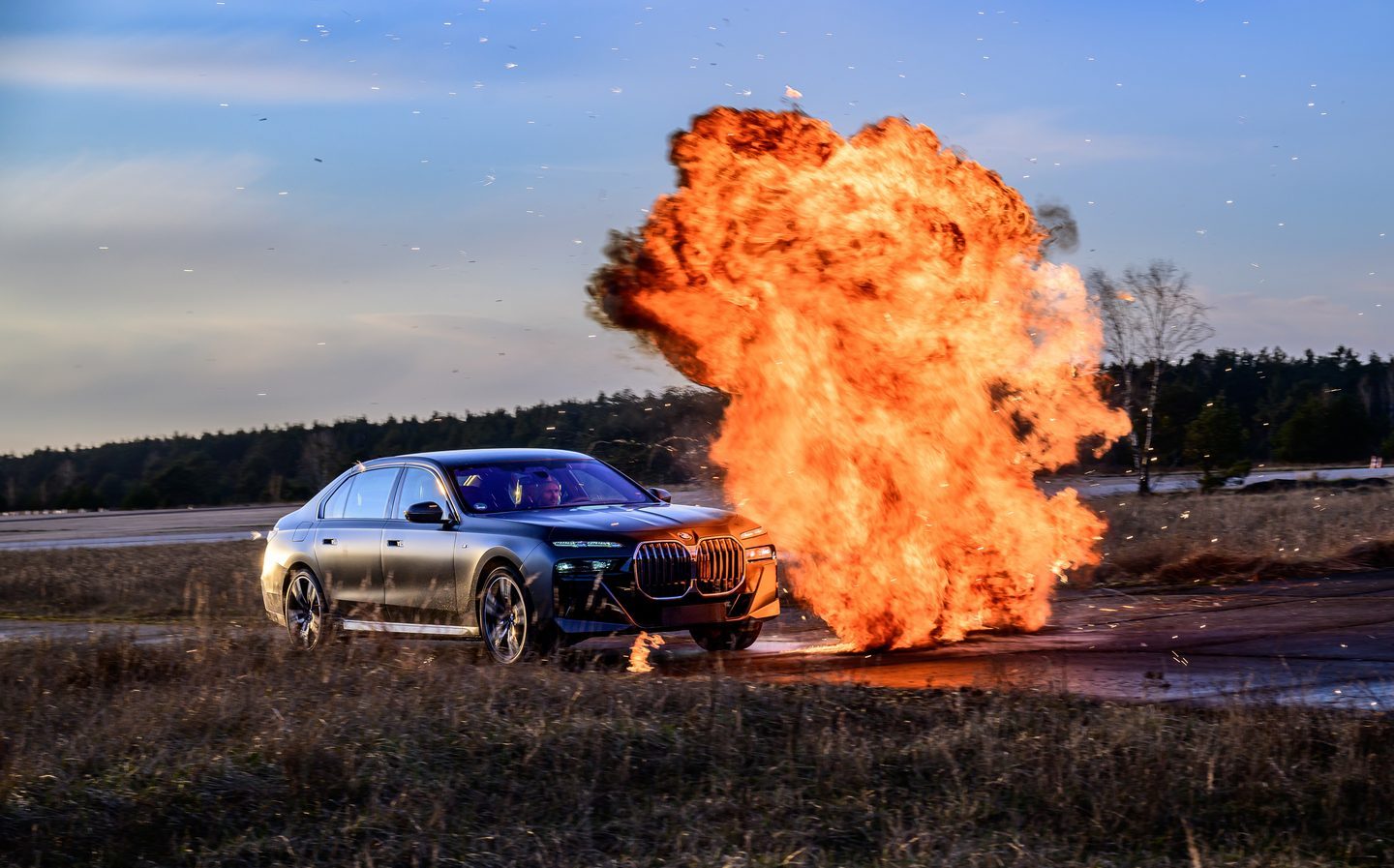Dodging firebombs in the BMW i7 Protection: An electric limo that can protect you from big bullets and small explosives
Trained bodyguard not included
It’s pitch black. Dark enough to clearly see star constellations in the sky above us. But I don’t have time to marvel at the view as my eyes are out on stalks, straining to see out of the windscreen in front of me as we hurtle along at 60mph with nothing more than parking lights on. Readers, do not try this at home.
After what seems an age, two dull lines of cones become visible only metres in front of the car and it’s time to slam on the brakes with full force. A fireball explodes in the right-hand escape road, so we veer into the alternative on the left and bring the car to a stop within the allotted space.
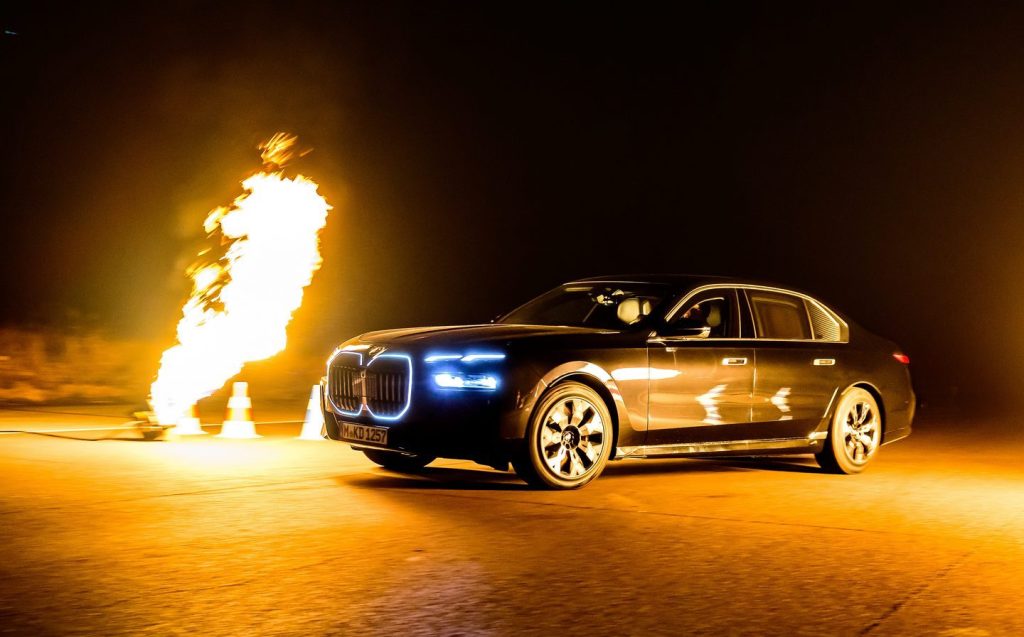
Heart still thumping, a voice squawks over the walkie-talkie: “Good, though you could have left more space between you and the hazard. Again!”
Welcome to the rather unique world of BMW Security Vehicle Training that bodyguards and special forces undertake to prepare for a working life at the wheel of an armoured car.
Remote facility to allow pyrotechnics
We’re about 40 miles north of Berlin at the Groß Dölln airfield, built by Soviet Russia in the early 1950s and once the largest military facility of its kind in Europe, covering more than 1,500 hectares of land. The Russian Air Force departed in 1994 following the reunification of Germany and, though used for private aircraft through the years, most of its large runways and land are now covered by solar panels. Indeed, Siemens has an “eHighway” on site for research and development.
More pertinent to our needs, there are still acres of concrete used by different companies for various driver training courses. There’s a modern, undulating racing circuit there, for example, while a veritable maze of roads criss-cross the facility, though it all feels a little rough and ready and it’s not difficult to imagine a big Russian bomber touching down on the scarred concrete, even today.
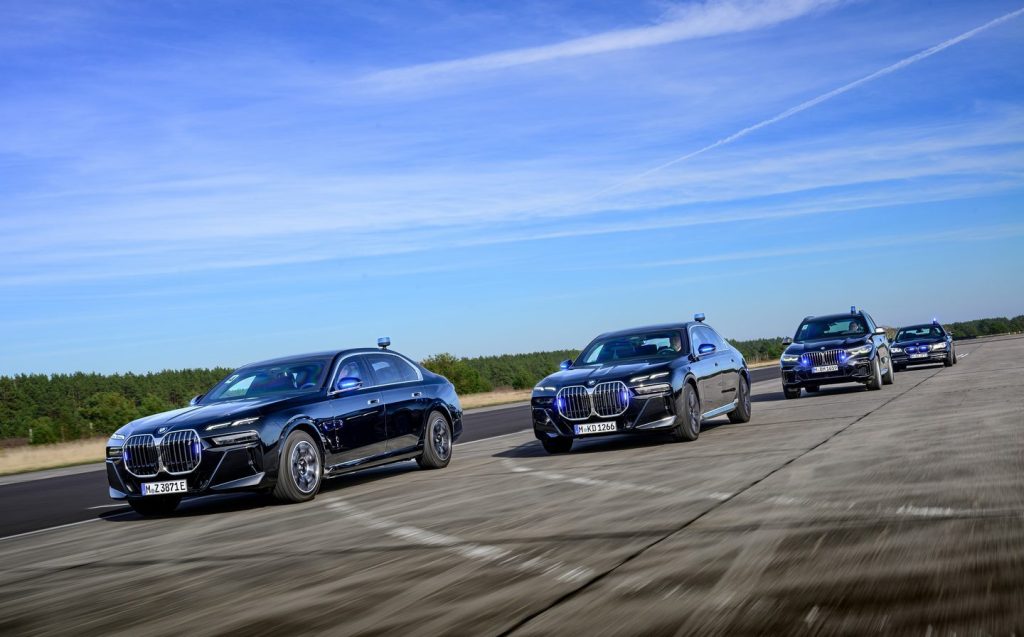
BMW runs driver training of various kinds at facilities around the world, mostly on racetracks, but this venue is used for the very specific needs of training to drive armoured vehicles, as its remote location allows the use of loud pyrotechnics and driving at night. BMW Protection makes armoured versions of the German firm’s cars to protect its clients from, in layman’s terms, ‘the bad guys’.
Only available to the good guys
Perturbingly, we are talked through the different levels of “badness” and the needs of BMW Protection’s clients. The obvious buyers of such vehicles are government agencies, requiring protection for officials and dignitaries. These don’t care about BMW’s ability to customise the look and feel of the cars, only the technical specifications.
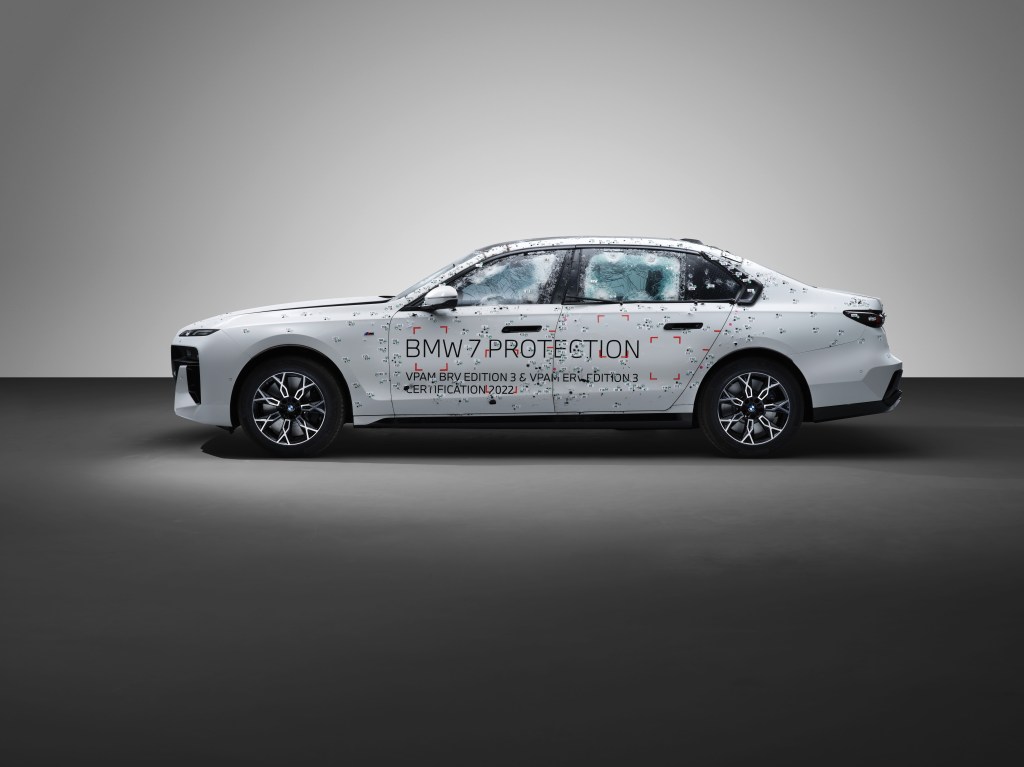
But we’re told there are strong sales in some markets — notably South America and South Africa — from private individuals who feel the need for more protection than a normal car can provide, and who also like the finer things in life.
However, when an order comes into BMW Protection from the local market, all buyers are vetted centrally in Munich before any sale is approved. Likewise, almost all examples of used armoured BMWs come back to the firm for internal use or reselling to select customers. In theory, a modern-day Pablo Escobar couldn’t get his hands on an officially-made armoured BMW even if he wanted to. Though I’d not like to be the one that has to say no.
This is a good time to point out that there’s more to all this than a car being armoured or not — there’s a whole series of classifications, mostly defined by the type of munitions the car can withstand. VPAM, which stands for Vereinigung der Prüfstellen für angriffshemmende Materialien (Association of Testing Institutes for Attack-Resistant Materials) is responsible for the definitions, the latest of which start with “VR” for Vehicle Resistance. This indicates that that entire vehicle has been certified, not just the individual materials used.
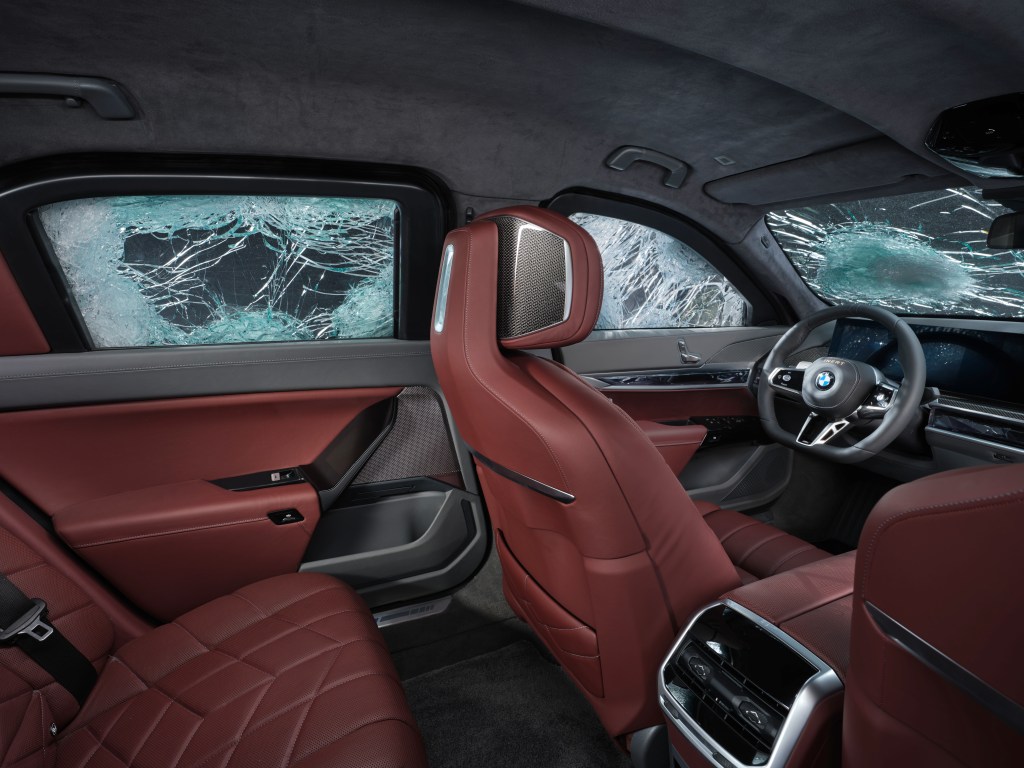
VR4, for example, can withstand low-velocity pistol ammunition, while VR7 requires 7.5mm-thick ballistic steel at a minimum, to withstand assault rifle fire from the likes of the AK-47, which is possibly the most wide-used shoulder weapon in the world. The top rating is VR10, with 18mm ballistic steel used to fend off armour-piercing rifle rounds and even hand grenade explosions. And that’s before the special multi-layer glass is taken into consideration.
Choice of X5 or 7 Series
BMW offers armoured versions of both the X5 SUV and the 7 Series luxury saloon. The former is to VR6 standard, protecting against higher-velocity pistol fire. Its armour adds about a tonne of weight to the donor car (so it’s about 3,400kg in total) and while BMW Protection doesn’t like to talk in absolutes when it comes to pricing, one insider did concede that “you wouldn’t get one for twice the price of the standard car.”
Given the X5 M60i xDrive — with which the X5 Protection VR6 shares its 523bhp twin-turbo V8 — starts at over £90,000, the armoured model must be knocking on for £200,000. The VR9 and VR10 cars cost considerably more.
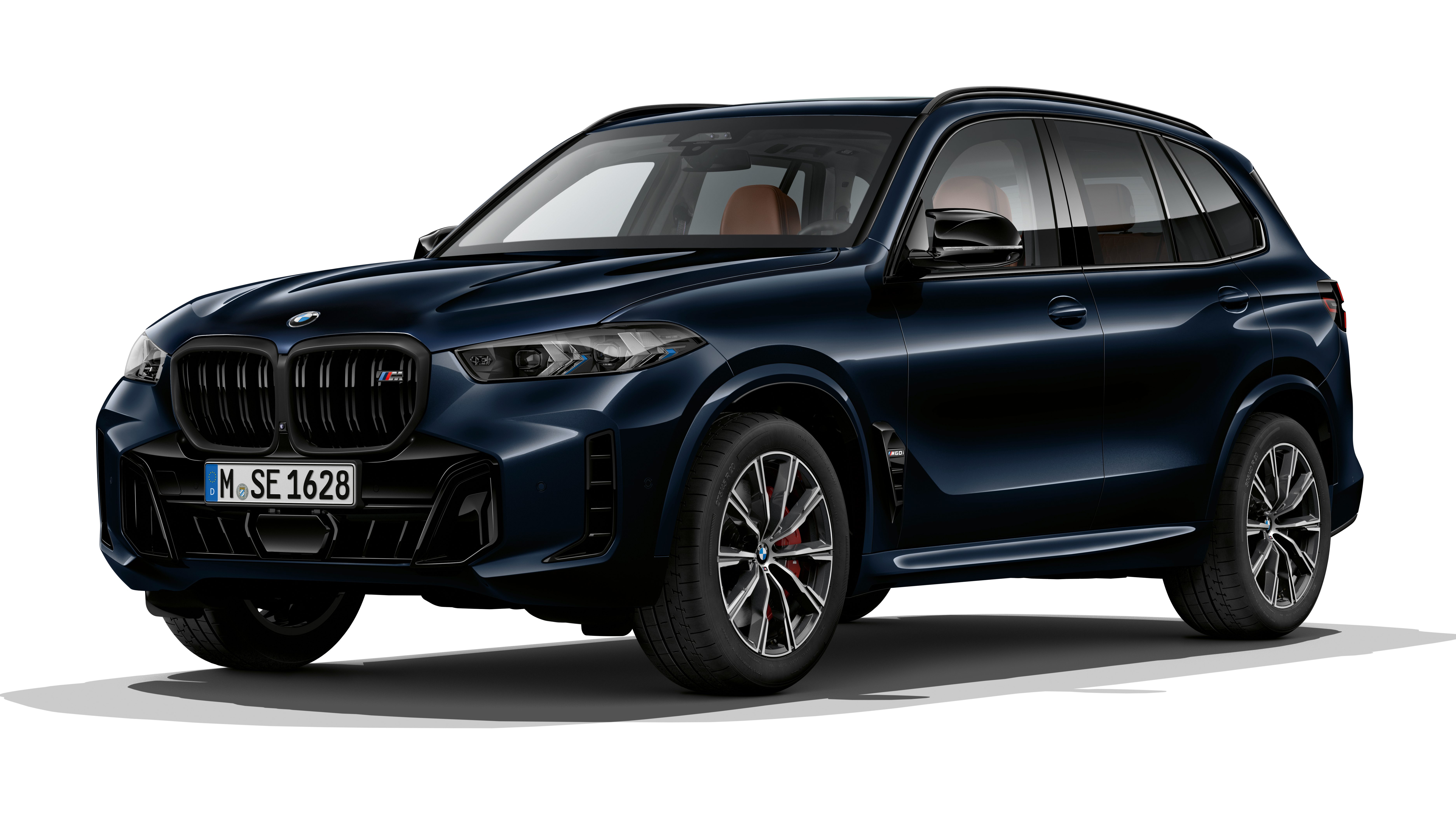
The X5 Protection VR6 starts its life on the same production line as most BMW X models in Spartanburg, USA. It’s then shipped to Mexico for the conversion, where BMW has a special unit dedicated to armouring cars. The location is conveniently close to one of the X5 Protection’s biggest markets and VR6-level cars such as this are used by their owners going about their daily business.
They’ll have strong arms from opening and closing the heavy doors, but once those are closed, it’s not easy to tell an armoured X5 apart from a regular one; something BMW makes a big deal of in its marketing of Protection vehicles. I.e. you don’t have a target on your back by driving one of these around.

While the armoured X5 has adaptive damping, a rear differential lock, active roll-stabilisation and even rear-wheel steering to enhance manoeuvrability, it does without air springs and a variable ride height, so its off-road ability is limited by the ground clearance. However, it proves more than capable over a short off-road course in dusty conditions and the brakes coped well with repeated stops from high speed on a section of disused runway, too. Indeed, it even managed high-speed lane changing under heavy braking without any drama.
Interestingly, VR6 cars are often driven alone by their owners, or they’re used as escort vehicles by a security detail keeping an eye on the endangered client in their VR9 or VR10 car. The latter are almost never driven by the person under protection, and the car never travels unaccompanied. The protected could in theory be ushered into the back of the X5 and taken across country where the VR9/10 car couldn’t go, to escape a dangerous situation, for example.
First time with electric power
One of the main reasons we’re in Germany is to try out BMW Protection’s newest offering. It’s based on the current 7 Series and for the first time available with electric power as the i7 Protection. This is a VR9 car, though if buyers really need VR10 protection then they have to stick with the petrol-fuelled 7 Series Protection instead.
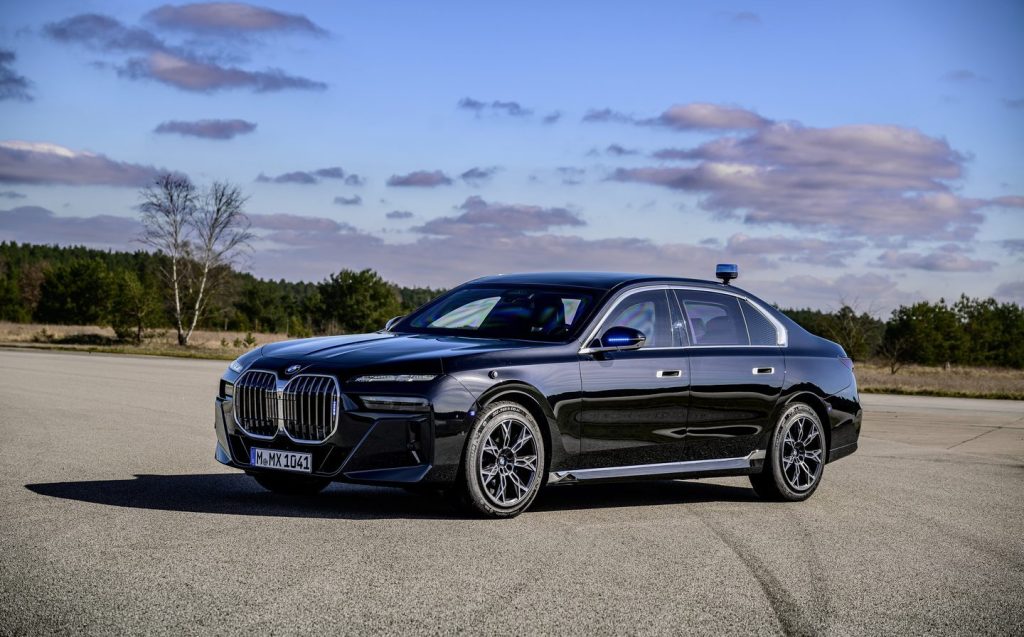
The latter is based on the 760i xDrive model, powered by the same V8 engine as found in the X5, which it’ll need to make decent progress given it can weigh as much as 3,890kg. Nevertheless, BMW quotes a highly respectable 6.6-second 0-62mph time for this car, and it’ll top 130mph as well.
The top speed is actually limited by the tyres’ capability. These are Michelin items using its “Pax” run-flat system employing a semi-rigid ring in the middle that supports the tyre even if it has been shot full of AK-47 bullets.
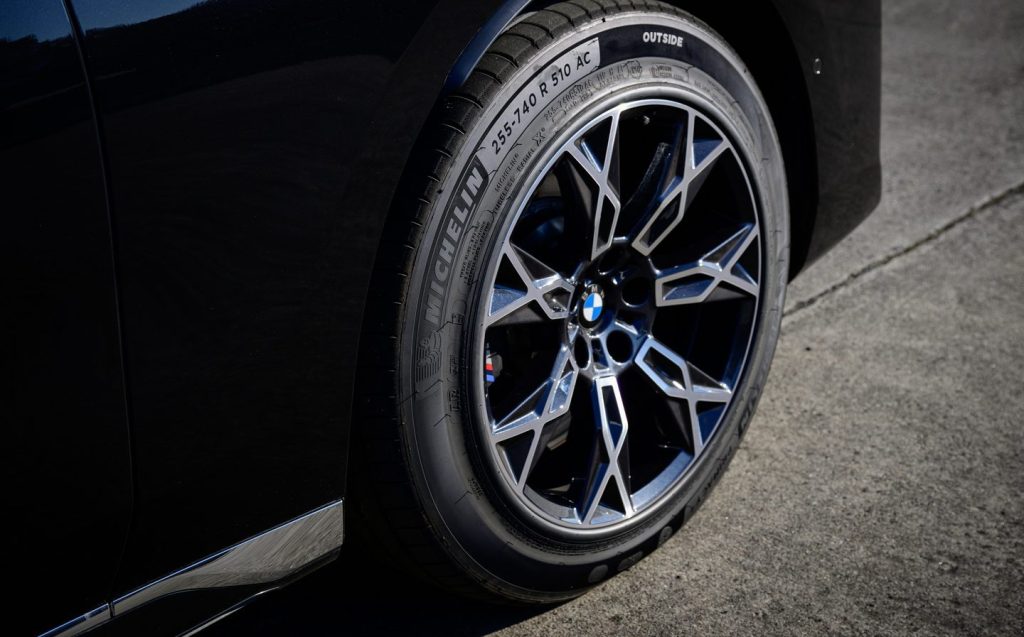
It requires a special wheel rim, too, and BMW has developed two different styles to match those of non-Pax alloy wheels available elsewhere in the 7 Series line-up in a bid not to draw attention to the car.
To accommodate extra armour under the battery pack, the i7 Protection sits higher on its springs, though this is disguised somewhat by new wheelarch spats that fill in some of the extra space.
Of course, if you want the full government-spec, blue-flashing-light effect instead of subtlety, there are plenty of add-ons you can specify at the time of ordering your armoured 7 Series.
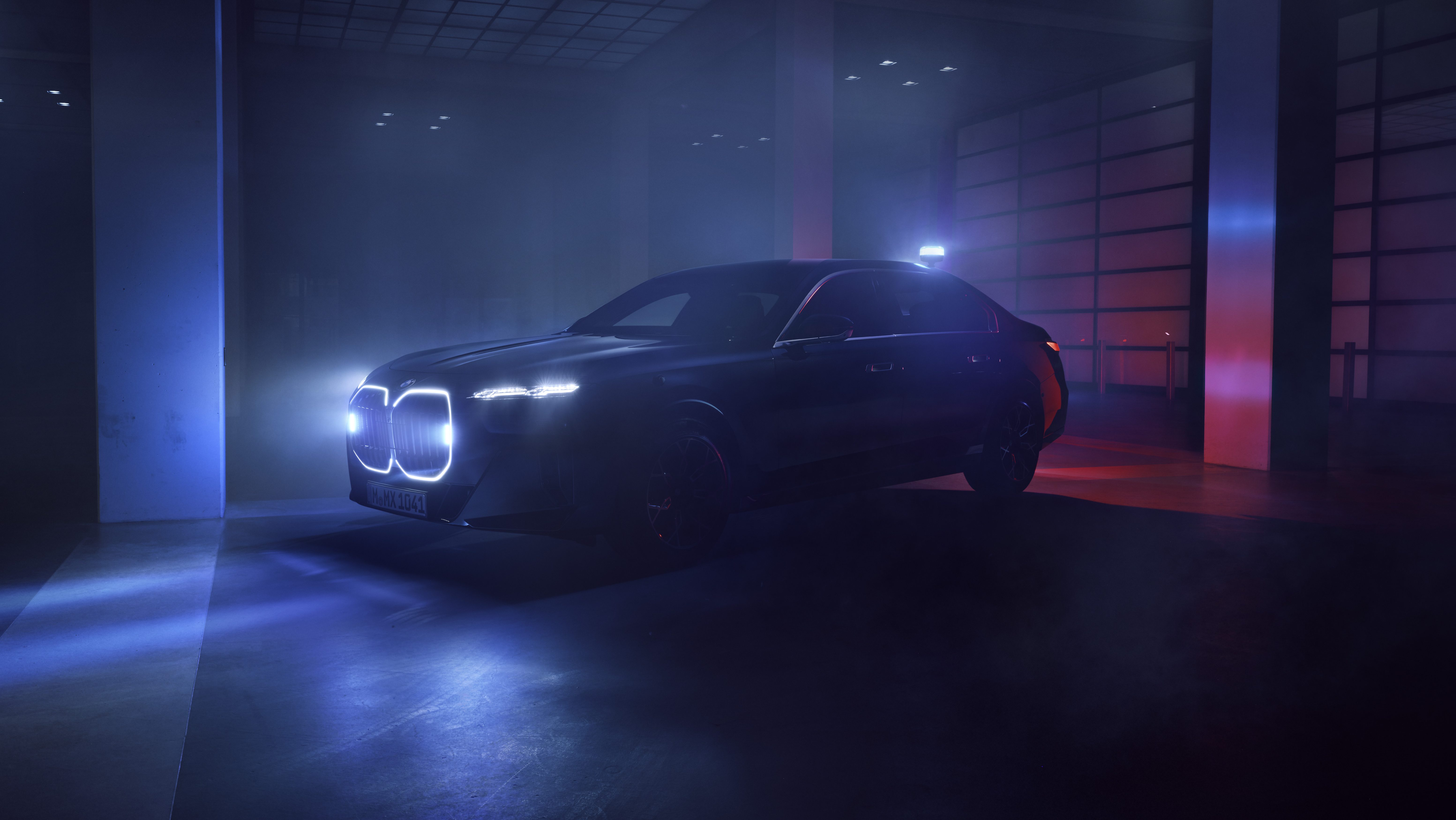
It’s a luxury car inside
Each of the doors in this car weighs 200kg, so BMW installs its “Effortless Doors” system — as found in various cars from Rolls-Royce, which is owned by the German company — to help ease the strain getting in and out, and stop the door accidentally amputating an arm if a gust of wind catches it. So instead you can open and close the doors at the press of an icon on a special new menu in the touchscreen system.

This menu also allows control of the fresh air system, the external communications (so you don’t have to crack open a window to speak to someone outside), special lighting, fire extinguishers and more. It’s even possible to literally blow the doors off if an emergency evacuation is required.
The integration of the controls is exceptional and as it’s all on the touchscreen, a casual glance inside won’t reveal the true nature of the vehicle. Tap on any of the glass, however, and the disconcerting solidity will leave you in no doubt.
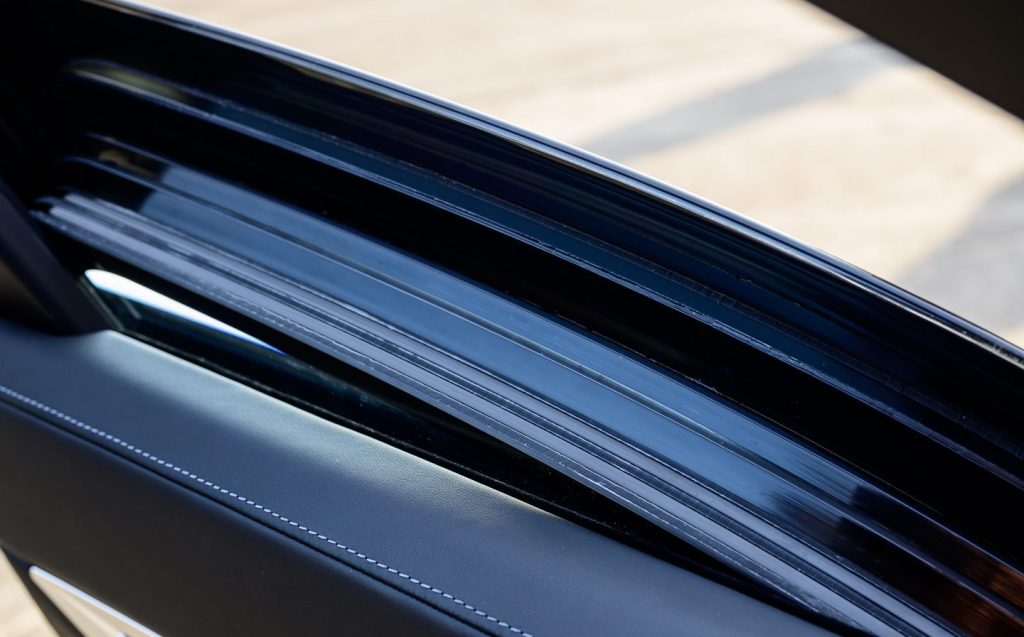
BMW allows buyers to individualise the 7 Series Protection just as they would any 7 Series, in terms of trim, materials, etc. It’s even possible to finish the exterior in two-tone paint, though the painting process is a little different to that for the unarmoured car. Normally, a car’s doors and all panels are mounted before it is dipped in paint, but the 7 Series Protection with its doors on is too heavy for the paint shop’s machinery so they’re done separately.
The i7 Protection weighs significantly more than four tonnes, and it would be heavier again if it weren’t built from the ground up as an armoured car. Unlike the X5, the 7 Series Protection isn’t a conversion of a regular car off the production line. Instead, the standard car’s “Carbon Core” structure is replaced by one made of armoured steel — BMW calls it the “Protection Core” — and this means a lot less additional armour is required to meet certification.
It also means the Protection version is virtually as spacious and luxurious as the regular models where most armoured cars come with a more-cramped cabin.
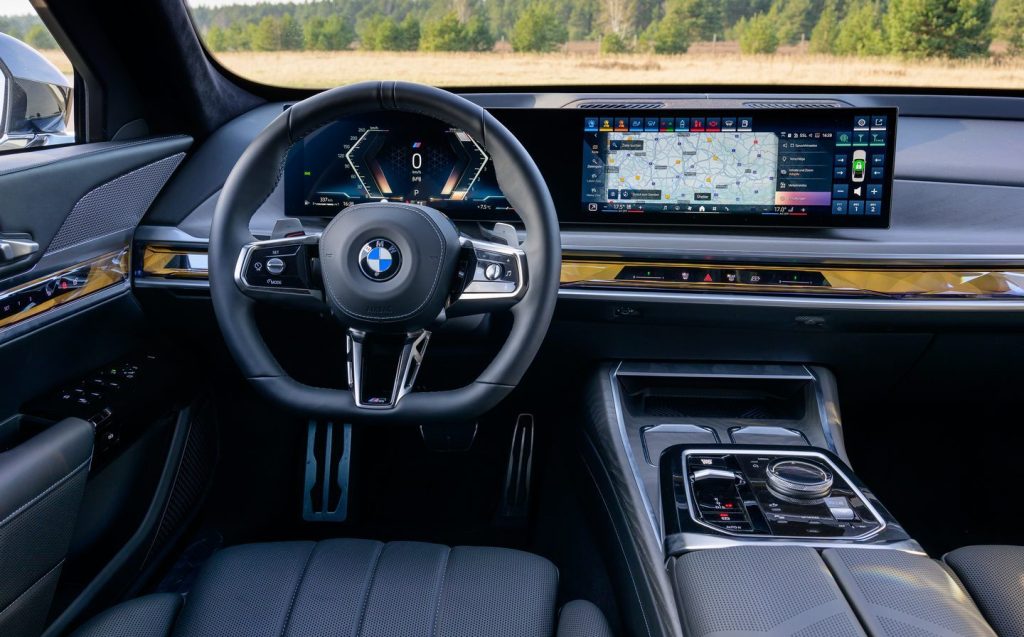
Range less important than protection
Naturally, carrying around so much weight, the i7 Protection can’t get anywhere near as much range as the standard xDrive60 model on which it’s based. The same 101.7kWh battery pack is used, which allows up to 124 miles (on the official WLTP test) before needing to recharge — against 386 miles for the non-armoured car.
That isn’t much, but the electric version is chosen by those who want the clean image to go with their self-preservation, and the car is expected to be used for special occasions. Indeed, we were told that for anything much over 150 miles, a helicopter is the default choice of transport for this sort of clientele.
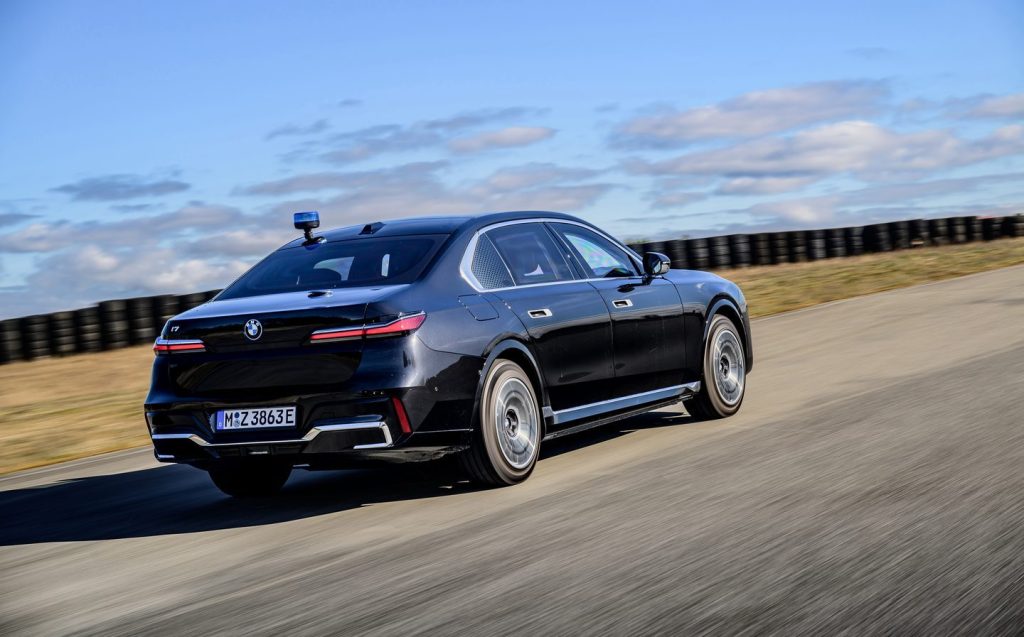
Although the i7’s peak power and torque figures are comparable to the 760i’s, its considerable extra weight means further-blunted performance. Hence a lukewarm 8.1-second 0-62mph time. The difference between the two is impossible to miss when driven back-to-back, but the i7 still performs better when driven to its limits than something weighing nearly five tonnes has any right to.
Tailored driver training
BMW provides tiered training “for participants who, as professional drivers, are responsible for the safety of their passengers”.
We were taught basic driving techniques using the heavy cars to start with, then moved on to evasive manoeuvres at various speeds. We were introduced to the challenges of reversing at speed — and under duress — and in another exercise actual petrol bombs were fired at us as we navigated unfamiliar roads with a simple instruction to protect our “charge” on board. Finally, we came back to the facility at night to repeat some of the challenges.
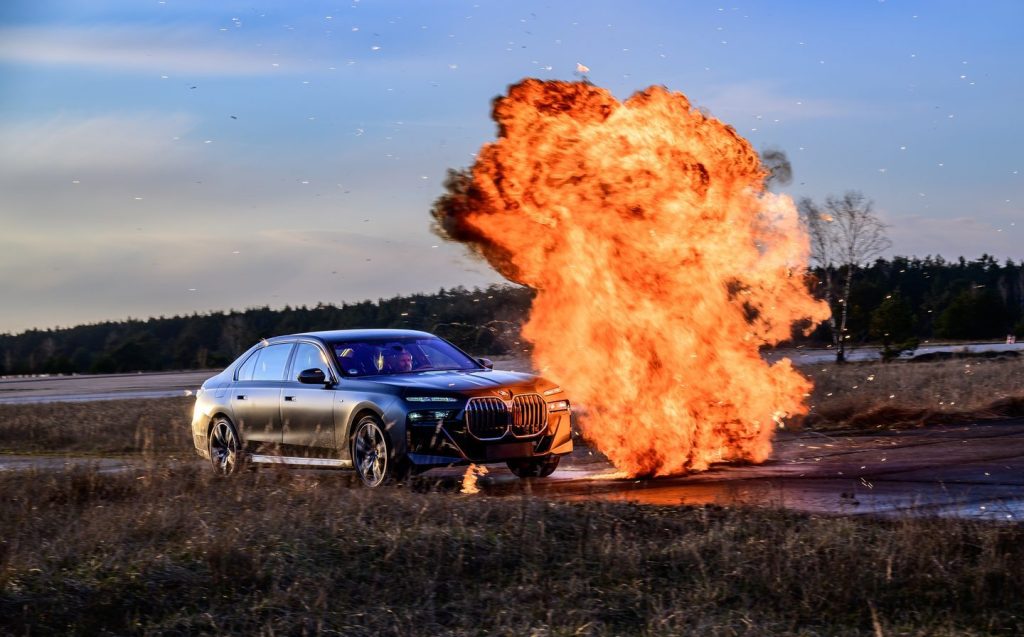
The Level 2 course over three days teaches tactics as well as driver training, while the latter is ramped up to include avoidance manoeuvres under fire and with vehicle contact resulting in “significant bodywork damage”.
As we underwent our training in shiny new cars, we noticed dozens more parked up wearing battle scars rather more extreme than you’d get in a supermarket carpark.
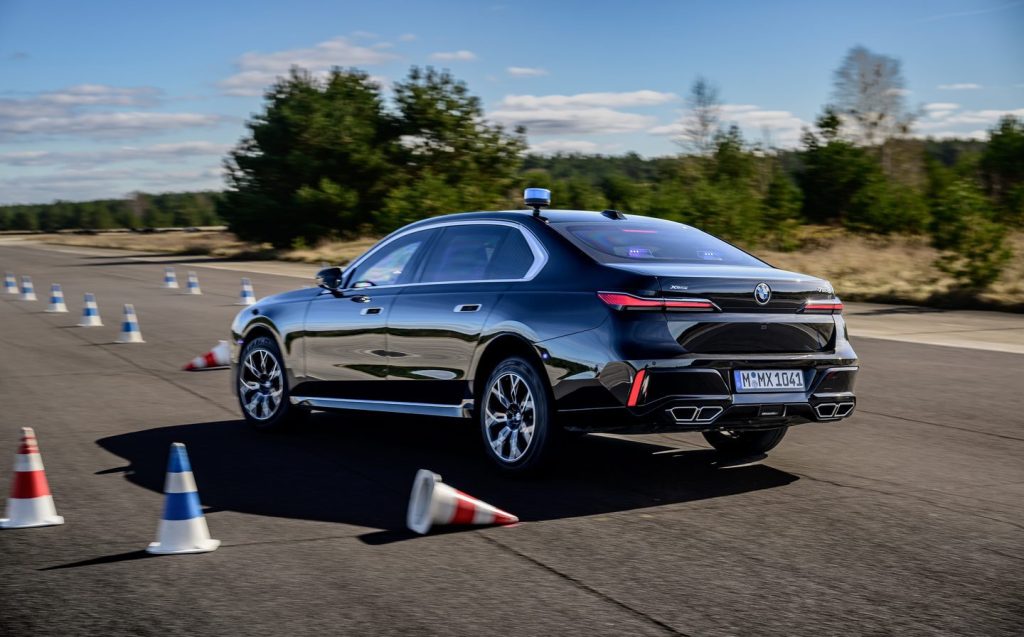
To those on the outside of this shady world it all sounds very exciting, but in actual fact the trainers repeat the exercises over and over again until the participants are quite literally bored with them. The idea is that they can continue to think clearly in an emergency situation while performing evasive action, using muscle memory to take control of the driving aspect. They could potentially do that with their eyes closed. Or in the dark as it happens.
Related articles
- If you found our review of the BMW i7 Protection interesting, you might want to read our review of the BMW i5
- You might also like to read our review of the BMW M3 Touring
- Or, check out the best luxury cars to buy
Latest articles
- Aston Martin Valkyrie AMR-LMH hypercar hits track ahead of 2025 Le Mans challenge
- Porsche has begun testing the electric Cayenne
- Cupra Leon 272 eHybrid 2024 review: Bigger battery, better tech … but is it a Cupra?
- Porsche 911 GTS 2024 review: Hybrid heresy or more Stuttgart genius?
- Extended test: 2023 Vauxhall Astra Sports Tourer GS PHEV
- Ford Capri revival has faced a lot of flak… but are buyers put off? Here’s what visitors to the Festival of Speed had to say
- F1 2024 calendar and race reports: What time the next grand prix starts and what happened in the previous rounds
- ‘No timeframe’ for how long Volvo’s returning estate cars will be on sale in UK
- Kia Picanto 2024 review: Updates add spice to cute Korean city car


